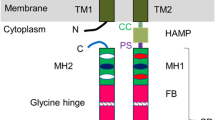Abstract
Several derivatives of the coprogen and ferrichrysin classes of siderophores were synthesized as potential affinity labels of the iron uptake system inNeurospora crassa. While only one of these compounds has proved useful as an affinity label, all were recognized and transported byNeurospora crassa. One derivative, chloroacetyl-ferrichrysin, proved to be an unexpectedly potent reversible inhibitor (K 1=0.4 μM) of both ferrichrysin and coprogen uptake, similar to the natural siderophore, ferrirubin. The reported results provide further understanding of the steric and electronic requirements of siderophores for the iron uptake system inNeurospora crassa.
Similar content being viewed by others
Abbreviations
- amu:
-
atomic mass units
- DMF:
-
dimethylformamide
- FAB:
-
tast atom bombardment
- NMR:
-
nuclear magnetic resonance
- ppm:
-
parts per million
- tlc:
-
thin layer chromatography
References
Bailey CT, Kime-Hunt EM, Carrano CJ, Huschka HG, Winkelmann G (1986) A photoaffinity label for the siderophore-mediated iron transport system inNeurospora crassa. Biochem Biophys Acta (in press)
Baker BR (1967) Design of active-site directed irreversible enzyme inhibitors. John Wiley, New York
Carrano CJ, Raymond KN (1979) Coordination chemistry and microbial iron transport. Acc Chem Res 12:183–190
Datta-Gupta N (1973) Synthesis and study of alkylating and/or radiation potentiating agents derived from aromatic arsenicals and porphyrins. Dissertation, State University of New York at Buffalo
Emery T, Emery L (1973) The biological activity of some siderochrome derivatives. Biochem Biophys Res Comm 50:670–675
Emery T, Neilands JB (1960) Contribution to the structure of the ferrichrome compounds: Characterization of the acyl moieties of the hydroxamate functions. J Am Chem Soc 82:3658–3662
Ernst J, Winkelmann G (1974) Uptake of iron byNeurospora crassa. IV. Iron transport properties of semisynthetic coprogen derivatives. Arch Microbiol 100:271–282
Fias EH, Stanley-Samuelson P, Neilands JB (1982) Properties and proteolysis of the ferric enterobactin outer-membrane receptor inE. coli K 12. Biochemistry 21:4517–4522
Hider RC (1984) Siderophore mediated absorption of iron. Structure and Bonding 58:25–87
Huschka H, Winkelmann G (1985) Molecular recognition and transport of siderophores in fungi. First International Symposium on Iron Transport-Storage-Metabolism
Huschka H, Naegeli HU, Leuenberger-Ryf H, Keller-Schierlein W, Winkelmann G (1985) Evidence for a common siderophore transport system in the presence of different siderophore receptors inNeurospora crassa. J Bacteriol 162:715–721
Keller-Schierlein W (1963) Über die Konstitution von Ferrirubin, Ferrirhodin und Ferrichrom A. Helv Chim Acta 46:1920–1929
Keller-Schierlein W, Diekmann H (1970) Stoffwechselprodukte von Mikroorganismen; Zur Konstitution des Coprogens. Helv Chim Acta 53:2035–2044
Llinas M, Klein MP, Neilands JB (1972) The solution conformation of the ferrichromes. II. Proton magnetic resonance of metal-free ferricrocin and ferrichrysin, conformational implicatons. Int J Peptide Protein Res 4:157–166
Muller G, Raymond KN (1984) Specifically and mechanism of ferrioxamine-mediated iron transport instreptomyces pilosus. J Bacteriol 160:304–312
Muller G, Matzanke B, Raymond KN (1984) Iron transport instreptomyces pilosus mediated by ferrichrome siderophores, rhodotorulic acid and enantio-rhodotorulic acid. J Bacteriol 160:313–318
Neilands JB (1984) Methodology of siderophores. Structure and Bonding 58:1–24
Raymond KN, Muller G, Matzanke BF (1984) Complexation of iron by siderophores. A review of their solution and structural chemistry and biological function. Topics in Curr Chem 123:49–102
Winkelmann G (1974) Uptake of iron byNeurospora crassa. III. Iron transport studies with ferrichrome-type compounds. Arch Microbiol 98:39–50
Winkelmann G (1979) Evidence for stereospecific uptake of iron chelates in fungi. FEBS Lett 97:43–46
Winkelmann G, Braun V (1981) Stereoselective recognition of ferrichrome by fungi and bacteria. FEMS Microbiol Lett 11:237–238
Winkelmann G, Huschka H (1985) Recognition and transport of siderophores in fungi. First International Symposium on Iron Transport-Storage-Metabolism
Wong GB, Kappel MJ, Raymond KN, Matzanke B, Winkelmann G (1983) Coordination chemistry of microbiol iron transport compounds. 24. Characterization of coprogen and ferricrocin, two ferric hydroxamate siderophores. J Am Chem Soc 105:810–815
Worcel A, Goldman DS, Cleland WW (1965) An allosteric reduced nicotinamide adenine dinucleotide oxidase frommycobacterium tuberculosis. J Biol Chem 240:3399–3407
Author information
Authors and Affiliations
Rights and permissions
About this article
Cite this article
Carrano, C.J., Bailey, C.T. & Bonadies, J.A. Transport properties of N-acyl derivatives of the coprogen and ferrichrysin classes of siderophores inNeurospora crassa . Arch. Microbiol. 146, 41–45 (1986). https://doi.org/10.1007/BF00690156
Received:
Accepted:
Issue Date:
DOI: https://doi.org/10.1007/BF00690156




